Burgle Bros. is a great cooperative board game
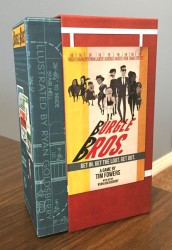
Don’t you just love a good heist movie?
Sure, you’d never attempt something like that yourself. But it sure makes for fun entertainment as you watch with anticipation how the thieves will escape. Because you know if they’re the protagonists, then in the end they’ll accomplish their goal.
No one wants to see a heist movie where everyone gets busted. That ruins the fun.
Ocean’s Eleven and Sneakers are some of our favorite heist movies where we’re rooting for the thieves to get away with the loot.
We’ll if you’d like to dive into such a make-believe setting yourself, we’d highly recommend you check out the cooperative board game, Burgle Bros.
How to play Burgle Bros.
Just like we’d imagine a real heist to be, Burgle Bros. is a challenging cooperative experience. Players work together to crack 3 safes and escape to the roof in order to win.
However, if they don’t stay clear of the guards, they’ll be caught, rat out the co-conspirators, and lose.
While playing, you’ll feel the tension build as you explore the 3 floors of the bank – setting off alarms, cracking safes to grab the loot, and trying to stay a step ahead of the guards on your way to victory. (Or terrible defeat – which can be a common outcome.)

Set Up
Setting up a game of Burgle Bros. is pretty straight forward.
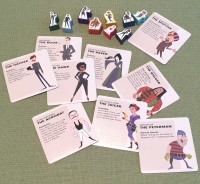
Each player takes a character card and selects one of that character’s special abilities to use throughout the game. The players then place that side of their character card face up in front of them. Each player also gets 3 Stealth tokens – which represent how many times they can be spotted by the Guards before they’re caught (and lose the game).
Then it’s time to construct the 3 floors of the bank. Each floor with have 1 Safe and 1 Stairway, so players set those 6 cards aside. Then they take the other 42 Floor tiles, shuffle them, and create 3 decks of 14 tiles each. Then they shuffle in 1 Safe and 1 Stairway into each floor deck of tiles and use them to construct the 3 floors – each into a facedown 4×4 grid of tiles.
Players then place 8 walls on each floor as shown in the rulebook. Once players have the hang of the game, they can also create unique floor layouts by putting walls in different places. Or you can use the wall randomizer on the Burgle Bros. website.
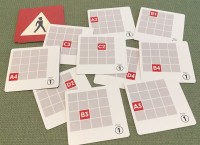
Next, players separate the Guard cards into their respective Patrol decks – 1 indicated deck per Floor. Each Guard uses a red die to represent their movement speed. The 1st Floor Guard has his set to 2. The 2nd Floor Guard has his set to 3. And, as you can imagine, the 3rd Floor Guard has his set to 4.
The first card on the 1st Floor Patrol deck is revealed and the Guard is placed on the corresponding tile in the grid.
Players then jointly choose a starting tile on the first floor and turn it over. Since this will be where they enter the building, they place a downstairs token on it. When each player takes their first turn, they’ll begin on this tile.
Then the next card in the Patrol deck is revealed and the 1st Floor Guard die is placed on this tile. It represents the direction the Guard will be headed.
Player Turns
A player can take up to 4 actions on their turn and can do the same action more than once. The options are:
- Reveal an adjacent tile (Peek)
- Move to an adjacent tile
- Hack a Computer
- Add a die to a Safe tile
- Attempt to Crack a Safe
1. Reveal an adjacent tile:
This is the cautious way to explore the bank. A player simply turns over a tile next to the spot they’re on. Tiles that are diagonal are not adjacent, nor are tiles through walls. It’s a slower way to explore, but less dangerous than the next option…
2. Move to an adjacent tile:
If the adjacent tile is already revealed, the player simply moves their character pawn to that tile. If it is still face down, the player turns it over as they move onto it. The danger in doing so is that the player may set off an alarm or fall to a floor below. But when a Guard’s closing in, sometimes it’s better to leap without looking first.
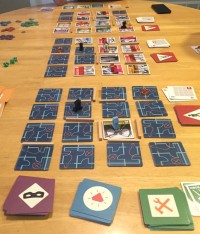
Stairs connect to the next floor or the roof (from the top floor). So players must reveal a Stair tile before they can move up to the next floor. When they move up for the first time, they place a downstairs token on that corresponding tile of that floor so they know they can move down a floor from that tile as well.
3. Hack a Computer:
When in a Computer room, a player can place a Hack token on that tile for an action. These tokens are used to stop alarms from sounding. For example, if you have Hack tokens on a Computer room that corresponds to Motion, when a player would normally set off a Motion alarm, a Hack token can be discarded from that Computer room to stop the alarm from taking affect.
4. Add a die to a Safe tile:
A player may spend 2 actions to permanently add a green die to a Safe tile. Since cracking the 3 Safes is the main goal of the game, players can increase their probability of success by adding more dice to a Safe tile.
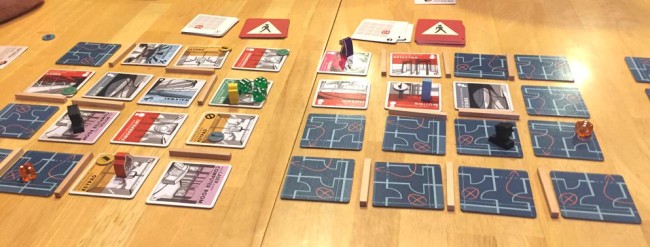
5. Attempt to Crack a Safe:
A Safe’s combination is represented by the small number in the bottom corner of each tile in that Safe’s row and column. So in a 4×4 grid, this means each combination consists of 6 numbers. So in order for players to crack a safe, they’ll need to reveal all the tiles in the same row and column of the safe. Players don’t need to reveal all of those tiles before attempting to crack the safe, but there are benefits for knowing first.
To attempt to crack a Safe, the player rolls all the green dice on that Safe tile. They then place a green safe token on each tile that matches the number shown on the dice. In addition, if there are multiple of the same number shown on the tiles, a token can be placed on each of the tiles when that number is rolled.
For example, if the numbers on the tiles in the row and column of the Safe are 2, 3, 3, 4, 5, 5, then only a 2, 3, 4, and 5 need to be rolled to open the Safe. Because when a 3 is rolled, a token can be placed on each tile that has a 3 on it – thus, the benefit to knowing the combination first. Because if you’ve rolled a 3 already and placed a token on a tile with a 3 and then later reveal a tile in the combination and it’s a 3, you must roll another 3 to place a token on that tile.
After cracking a Safe, that player draws a Tool card and a Loot card. The Tool can be used during the game and the Loot card must also be carried to the roof with the players to escape and win the game.
In addition, when a Safe is cracked, a silent alarm is triggered. The Guard on that floor as well as all the floors below will move faster. Their red dice are each turned up one pip.
If a player only uses 2 actions or fewer, they draw an Event card and do what it says (good or bad).
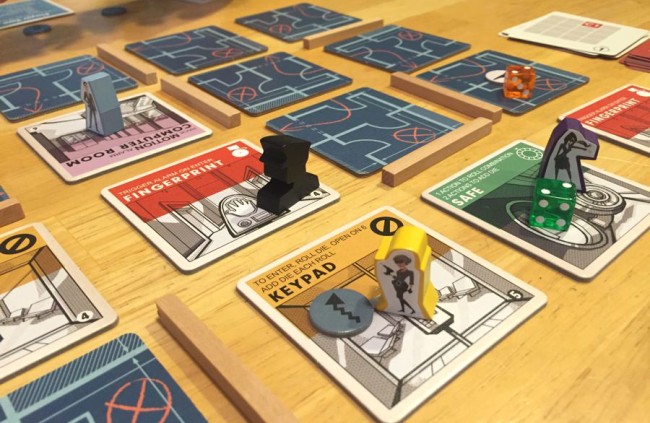
Guards Move
After each player’s turn, the Guard on that player’s floor will move.
The Guard will advance toward its red die target location and will move as many tiles at their movement speed. When the Guard reaches that location, another card in the Patrol deck is revealed for that Guard’s new target location. If the Guard still has movement points left, it will keep going.
In addition, when an alarm is triggered on the floor, the Guard’s location will move to that tile. Both an alarm token and the Guard die are placed on the alarm tile. If there is an alarm token on the floor, that adds another movement point to that Guard’s movement.
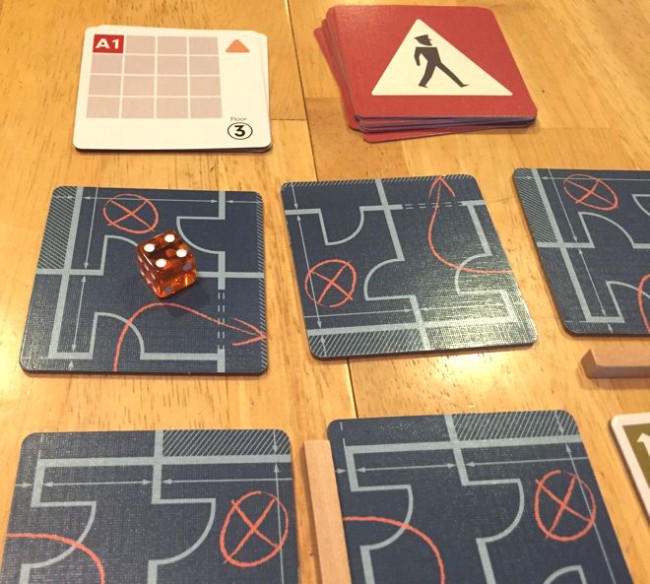
Game End
If a player’s character pawn and a Guard are ever on the same tile, the player is spotted and discards one of their Stealth tokens. (Some tiles also let Guards spot thieves from an adjacent tile.) If any player has discarded all 3 of their Stealth tokens and is then spotted by a Guard, they are captured!
They don’t do well when interrogated and cough up the names of all the co-conspirators and everyone loses the game.
If on the other hand, all 3 Safes are successfully cracked, the players can take their Loot and head to the roof. They all must leave through the Stairs tile on the top floor to win the game!
Can the whole family enjoy Burgle Bros.?
We’ve found Burgle Bros. a tough game to win. But even when we don’t win, we have a great time. Because it’s a cooperative game, it’s great for families to play together.
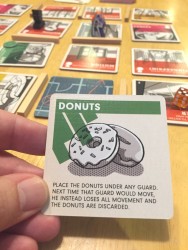
While younger kids may not grasp all their options and figure out optimal moves, we’ve found the game fosters plenty of discussion throughout. So parents and siblings can easily help the younger kids enjoy the game right along with them.
One outstanding question for family play may be the theme of the game. We can totally understand parents not wanting to glorify breaking into a bank to steal loot from the safes. And if that’s the case, there are plenty of other cooperative board games that may interest you more.
However, we think it’s like a cartoonized version of staying clear of the guards to get away with the treasures. We’ve had a lot of fun playing up the characters in this cat-and-mouse type experience. And we don’t feel any more inclined to rob a bank than we did before playing. Just as we don’t feel inclined to smash up New York City after playing King of New York.
What we like about Burgle Bros.
One of the things we enjoy most about Burgle Bros. is the randomness throughout the game. Even though the objective is the same every game, the way it plays out is completely different.
For starters, there’s the randomness of the of the Floor tiles. Before you dive in, you have no idea where anything is on the floors. So you have to start exploring and taking your chances in uncovering tiles to discover the Safe and the Stairs while watching out for the alarms. Sometimes the layout works in your favor and sometimes it doesn’t.
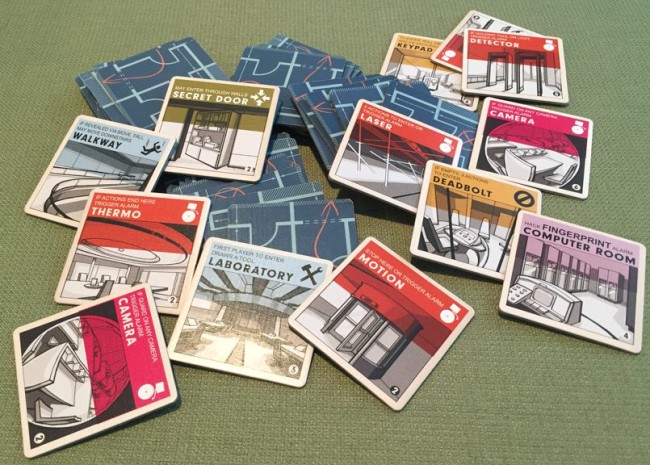
In one game it seemed like all the alarms tiles ended up on the 2nd floor. We were able to carefully work through that floor, but not before uncovering 10 alarms!
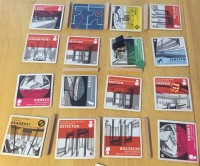
Out of the 16 tiles on the floor, that’s a ton! It’s a good thing we’d hacked a computer room on the first floor before going up.
Next is the randomness of the Guard movement. Every time he’d reach his destination, we’d hold our collective breath to see which card would turn up next to send him in a new direction.
And then there are the Event, Loot, and Tool cards. Only a few of these come out each game so you never know what you’re going to get. The Loot has to be carried out of the building, but while you’re carrying it, it has a negative effect that needs to be dealt with. And the Tool cards can really help out in a pinch.
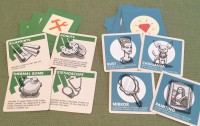
Which leads to our top reason why we like Burgle Bros. – working together.
Yes, this is the case in all cooperative games, but Burgle Bros. feels a bit different. We haven’t found an alpha-gamer problem where one person just tells the other people what to do. Instead we’re all pitching in ideas of possibilities.
Because of the randomness in the other aspects of the game, we never know for sure what the next action will bring (like moving to an uncovered tile). So it’s up to the player to make their own decision and we’ll all deal with the outcome together.
And when different events happen in the game, we’re totally playing it up like a movie. Whether were setting off an alarm on purpose to distract a guard, slipping into a computer room to hack a computer, or getting away through a service duct, we’re imaging it playing out with sound effects and all. Lots of fun!
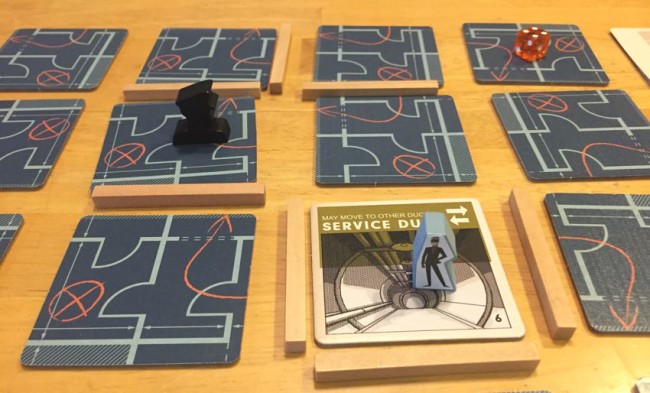
Go 3D!
Another way to play Burgle Bros. is with a 3D bank tower!
As you can see in our photos, the normal with to play the game is with all 3 floors arranged on the table in their 4×4 grids.
However, there are a few companies that also offer a tower for Burgle Bros. so you can really get the feel of operating a heist in a 3-story bank building.
We got a 3D tower for Burgle Bros. from Daft Concepts at SaltCon earlier this year and it adds a lot of fun to the game. For some players with large hands, moving characters around and flipping tiles on the first couple floors can be a challenge, but it’s still a cool way to play.
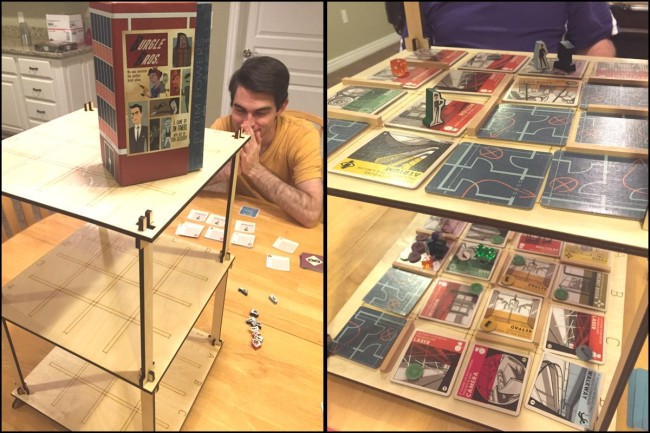
How does Burgle Bros. score on our “Let’s Play Again” game meter?
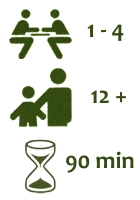 As you may have guessed, Burgle Bros. scores high on our “let’s play again” game meter. It’s a fun game that always keeps us on our toes.
As you may have guessed, Burgle Bros. scores high on our “let’s play again” game meter. It’s a fun game that always keeps us on our toes.
Whether we win or lose, at the end of a game we’re still excited for the next time we’ll pull out the game.
While we haven’t played multiple games back-to-back because of the game length, it’s definitely one of our favorite cooperative board games to play that delivers on the fun every time.
Thanks Tim Fowers, for a great cooperative board game and Daft Concepts for a cool Burgle Bros. tower!

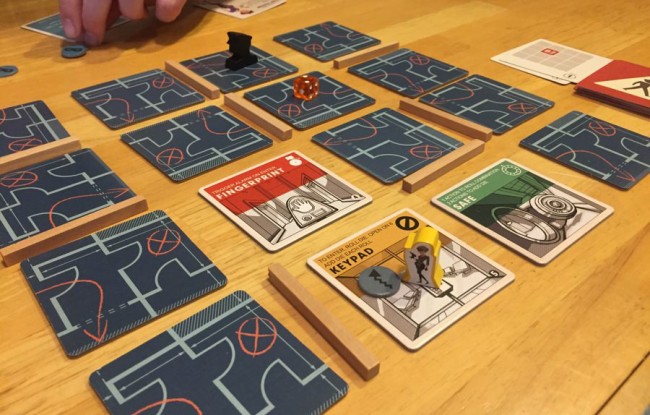
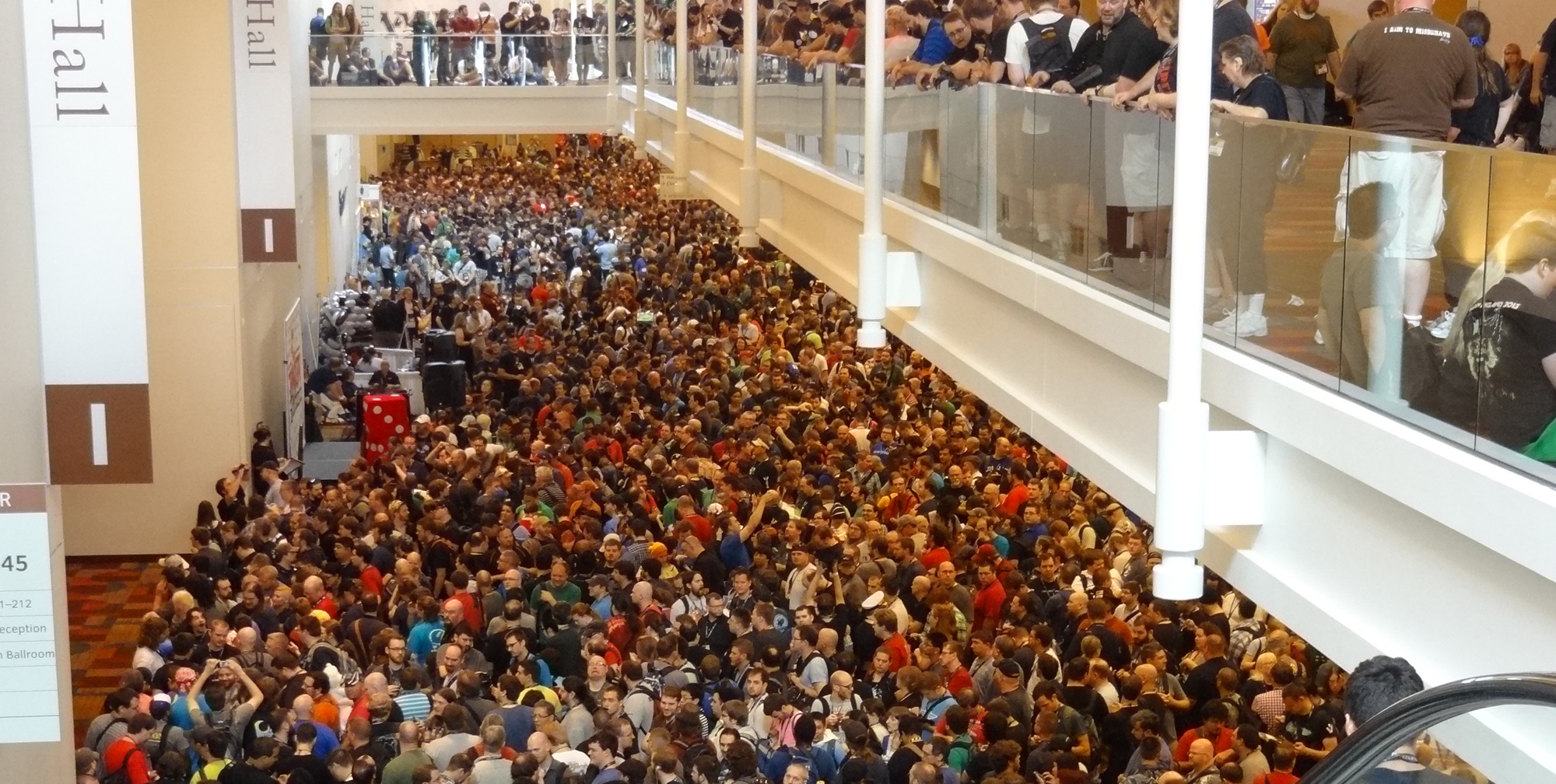

I ordered this game off of your review alone and I absolutely love it! It finds its way to the table almost every week with my gaming group. Thank you for all the great reviews.